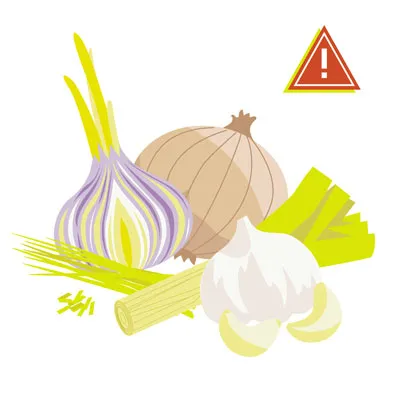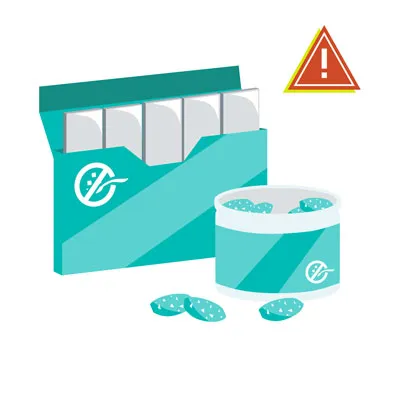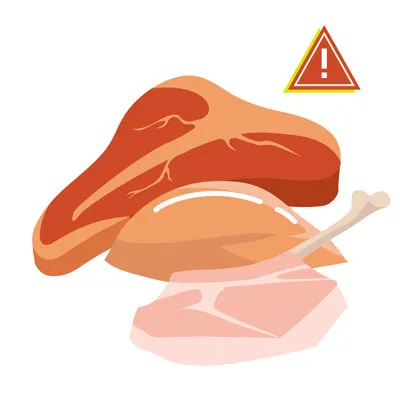As devoted pet parents, ensuring our furry friends enjoy a long, healthy life is a top priority. A crucial aspect of this care involves understanding their diet, particularly what foods dogs can and cannot eat. While some human foods are perfectly safe and even beneficial, many common household items can pose a serious threat, with some being toxic even in minimal amounts. The distinction between safe and dangerous can be complex, and accidental ingestions are a significant concern for pet owners, contributing to a substantial number of pet poisonings annually. This guide aims to equip you with essential knowledge about the foods dogs can’t eat, acting as a vital resource to help safeguard your canine companion.
Why Certain Foods Are Toxic to Dogs
The digestive systems and metabolic processes of dogs differ significantly from humans, explaining why many foods safe for us can be harmful to them. Dogs process certain substances in unique ways. For instance, compounds like theobromine and caffeine found in chocolate are metabolized much slower by dogs, leading to a rapid accumulation in their system that can quickly become fatal. Similarly, while cherries themselves are generally harmless, their pits, stems, and leaves contain cyanide, which can be problematic if consumed in large quantities. The pits can also cause gastrointestinal upset due to their indigestibility, making it safer to avoid them entirely.
The impact of food toxicity can also vary based on a dog’s size, breed, and existing health conditions. This highlights the importance of consulting your veterinarian if you have any uncertainties regarding specific foods your dog should avoid.
List of Common Foods Dogs Cannot Eat
Many everyday household foods are dangerous, and often toxic, to dogs. It’s crucial for pet owners to be aware of list of what foods dogs should not eat to prevent accidental poisoning. While this list is not exhaustive, it covers many of the most common and dangerous items your dog should never consume.
1. Alcohol
Due to their smaller size, alcohol has a much more potent and potentially deadly effect on dogs than on humans. Even small quantities can cause severe harm. The smaller the dog, the greater the danger posed by even a minimal amount. Symptoms of alcohol poisoning in dogs mirror those in humans, including vomiting, breathing difficulties, coma, and in severe cases, death.
 Alcohol in a glass next to a dog bowl
Alcohol in a glass next to a dog bowl
2. Apple, Apricot, Cherry, and Plum Seeds/Pits
While the fleshy parts of apples are safe for dogs, the core and seeds are not. Apple seeds contain cyanide, and while small amounts may not be immediately fatal, it’s best to remove the core and seeds completely. Similarly, the seeds and pits of apricots, cherries, peaches, and plums should be avoided. These also contain cyanide, which can disrupt red blood cells’ ability to carry oxygen, leading to symptoms like vomiting, irregular heartbeats, seizures, coma, and even death.
3. Avocado
Avocados are not a suitable food for dogs. Cases of myocardial damage have been reported in dogs after avocado consumption, although these specific outcomes haven’t been widely replicated. However, avocados are known to cause problems in other mammal species. Furthermore, an intact avocado pit can pose a serious choking hazard and cause gastrointestinal obstruction in dogs. For these reasons, it’s safest to keep avocados away from your dog.
4. Broccoli
Broccoli contains isothiocyanates, which can be harmful to pets in very large doses. While small amounts occasionally might be acceptable, it is generally recommended to avoid them given the abundance of other healthy and safe vegetable options. Additionally, broccoli stalks can be a choking hazard or cause an obstruction if they get lodged in a dog’s throat.
5. Caffeine and Coffee Grounds
Caffeine, present in coffee, tea, and energy drinks, contains methylxanthines. These compounds can cause a range of severe and potentially fatal symptoms in dogs, including diarrhea, vomiting, seizures, and an irregular heartbeat. Even accidental ingestion of coffee grounds can lead to a dangerously racing heart, tremors, arrhythmia, and difficulty breathing.
6. Chicken and Turkey Skin, Ham, and Other Fatty Cuts of Meat
Fatty cuts of meat, including ham and poultry skin, should be discarded rather than given to pets as treats. These items are bad for dogs due to their high-fat content, which can trigger acute pancreatitis—a painful and potentially life-threatening illness with serious complications. Owners should also avoid turkey and chicken bones as they can splinter, causing internal damage or obstructions that may lead to fatal abdominal infections.
7. Chocolate
Chocolate toxicity is a widely known danger for dogs. It contains theobromine, a compound that dogs cannot metabolize effectively. The darker the chocolate, the higher its theobromine content and the greater the risk. Chocolate also contains caffeine, and some sugar-free varieties may contain xylitol, both of which are highly toxic to dogs.
 Various types of chocolate bars and pieces
Various types of chocolate bars and pieces
Symptoms of chocolate ingestion include hyperactivity, vomiting, diarrhea, pancreatitis, abnormal heart rhythm, and seizures. If your dog consumes any amount of chocolate, contact your veterinarian immediately.
8. Grapes and Raisins
Grapes and raisins are dangerous to dogs and can cause severe problems, including acute kidney failure. The tartaric acid in these fruits is toxic to a dog’s kidneys, and even a small amount can wreak havoc. Symptoms of grape or raisin poisoning include vomiting, diarrhea, loss of appetite, and changes in urination patterns, ranging from increased to no urine production.
 Bowl of red grapes
Bowl of red grapes
9. Macadamia Nuts, Almonds, and Pistachios
Macadamia nuts are particularly toxic to dogs, causing symptoms like weakness, overheating, and vomiting. The exact mechanism of poisoning is not fully understood, but even a small quantity (as few as six nuts for a small dog) can lead to severe poisoning. While macadamia nuts are the most dangerous, other nuts like almonds and pistachios can pose choking hazards or become problematic if they are flavored or spiced.
10. Milk and Dairy Products
The suitability of milk and other dairy products for dogs depends on individual tolerance. Some dogs can consume them without issues, but many are lactose intolerant or have allergies, leading to diarrhea and gas from cow’s milk. Ice cream is generally bad for dogs due to its high sugar and fat content. As for cheese, small quantities of lower-fat varieties can be given as an occasional treat, but high-fat cheeses should be avoided.
11. Mushrooms
It’s best to avoid feeding your dog mushrooms, as some varieties contain toxins that can lead to kidney and liver failure, vomiting, diarrhea, hallucinations, and red blood cell damage. While washed white mushrooms from grocery stores might be safe, opting for a different, known-safe treat is the safer choice.
12. Nutmeg and Cinnamon
Nutmeg is highly toxic to dogs and should never be fed to them. It contains myristicin, a compound that can cause hallucinations and severe vomiting, especially in high doses or in smaller dogs. Cinnamon, while not strictly toxic, can irritate a dog’s mouth and, in some cases, lead to dangerous drops in blood sugar.
13. Onions, Garlic, Chives, and Leeks
Members of the allium family, including onions, garlic, chives, and leeks, are highly dangerous for dogs. They contain sulfoxides and disulfides that can damage red blood cells, leading to anemia. This risk extends to onion and garlic powders found in many prepared foods, so always check labels. All allium plants can cause potentially fatal anemia in dogs, with certain Japanese breeds like Akitas and Shiba Inus being particularly sensitive.
 Sliced onions, garlic cloves, chives, and leeks
Sliced onions, garlic cloves, chives, and leeks
14. Salt
Excessive salt intake can disrupt the fluid balance in a dog’s cells, leading to serious symptoms such as tremors, seizures, diarrhea, or even a coma. Whether it’s rock salt, homemade play dough, or salty potato chips, it’s crucial to prevent your dog from consuming too much salt.
15. Spicy Food
Keep your dog away from spicy foods. Hot and spicy ingredients can cause digestive upset, vomiting, stomach ulcers, or diarrhea, leading to discomfort for your dog and potentially costly emergency veterinary visits.
16. Sugar-Free Gum and Candy (Xylitol)
Xylitol is an artificial sweetener commonly found in sugar-free gum, candy, and many baked goods. It is extremely toxic to dogs, causing a rapid and dangerous drop in blood sugar that can lead to weakness, seizures, and even liver failure. Cases of xylitol poisoning are increasing, and the amount of xylitol in just five pieces of gum has the potential to be fatal to a 65-pound dog.
 Various sugar-free candies and gum
Various sugar-free candies and gum
17. Tomatoes and Raw Potatoes
Both tomatoes and potatoes have “safe in some forms, unsafe in others” categories. Ripe red tomatoes are generally safe. However, the green parts of the tomato plant and unripe green tomatoes contain solanine, which is toxic to dogs. Similarly, baked or boiled potatoes without additives are safe in small amounts, but raw potatoes also contain solanine and should be avoided.
18. Tobacco
Tobacco and nicotine-containing products are highly dangerous for dogs. Exposure can cause a range of symptoms including vomiting, diarrhea, rapid breathing, agitation, abnormal heart rate, wobbliness, muscle weakness, blood pressure changes, seizures, and tremors. More significant exposure can lead to blue gums, coma, and can ultimately be fatal. If your dog ingests any tobacco product, immediate veterinary attention is critical.
19. Yeast and Raw Dough
Yeast and raw dough are unsafe for dogs for multiple reasons. Raw dough can expand in a dog’s stomach, causing severe pain and potentially life-threatening gastric torsion or rupture. Furthermore, the yeast and sugar in raw dough ferment, producing alcohol, which can lead to severe alcohol toxicity that requires immediate medical intervention.
20. Raw Meat
Never feed your dog raw or undercooked meat. Raw meat can carry harmful bacteria like Salmonella or E. coli, which can sicken dogs just as they can humans. Additionally, bones in raw meat can pose a choking hazard or cause internal injuries. This is also important to consider when wondering what meat should you not give to dogs.
 Pieces of raw red meat
Pieces of raw red meat
21. Rhubarb
Rhubarb, often used in desserts, is not safe for pets. Its leaves contain soluble calcium oxalate crystals. If consumed in large enough quantities, these crystals can bind with calcium in the body, causing a dangerous drop in calcium levels and potentially leading to renal failure. Symptoms include tremors, weakness, drooling, bloody urine, changes in thirst and urination, and vomiting.
22. Star Fruit
Similar to rhubarb, star fruit also contains soluble calcium oxalate crystals and should not be given to your dog.
23. Flavored and Seltzer Water
It’s always safest to give your dog fresh, plain water. Flavored or carbonated waters can contain added ingredients like sugar or salt that are dangerous for pups. While plain seltzer water might be acceptable in small amounts in an emergency, it can cause gas and bloating. Stick to plain water for your dog’s hydration.
Foods Safe for Dogs
While the list of foods to avoid is extensive, many human foods are perfectly safe and healthy for dogs. Some of the best choices include plain, dehydrated chicken or beef in small amounts, apples (without the core), green beans, and carrots. This list is not exhaustive but provides a good starting point for safe treats:
- Fruits: Apples (flesh only), oranges (small amounts), bananas (peeled), blueberries, blackberries, cantaloupe, mango (peeled, pitted), peaches (pitted), pears (cored, pitted), pineapples (peeled, cored), watermelon (seedless, rind removed).
- Vegetables: Carrots, cucumber, celery, green beans (plain). These are great low-calorie options, especially for overweight dogs.
- Dairy (in moderation): Small amounts of low-fat cheese if your dog is not lactose intolerant.
- Eggs: Fully cooked eggs (scrambled) can soothe an upset stomach and provide protein.
- Nuts (in moderation): Unsalted, unflavored peanuts, peanut butter (xylitol-free), and cashews.
- Grains: Air-popped, unsalted, unbuttered popcorn (no unpopped kernels), plain corn (off the cob), wheat, quinoa. For dogs on special diets, understanding what can dogs eat on a raw diet can also be helpful, though raw meat itself carries risks.
- Other: Small amounts of coconut (milk, oil, flesh without furry shell), honey.
- Meat/Fish: Plain, fully cooked shrimp (shelled), plain, fully cooked, boneless fish (salmon, sardines, canned tuna in water), plain, cooked turkey (skin, fat, bones removed).
What Dogs Are Most at Risk if They Consume Toxic Foods?
While no dog should consume toxic foods, certain dogs are at higher risk if accidental ingestion occurs:
- Small breeds vs. large breeds: Smaller dogs are more vulnerable due to their lower body weight, especially with substances like chocolate. This is also a factor when considering what can t german shepherds eat, as their larger size may provide a slight buffer but doesn’t negate the danger.
- Puppies: Young dogs have less developed digestive and immune systems, making them more susceptible to certain substances, including potentially harmful bacteria found in raw foods.
- Elderly dogs: Older dogs may have pre-existing health conditions that increase their risk.
- Dogs with pre-existing conditions: Dogs with health issues like diabetes or kidney disease are at greater risk from toxic foods.
How To Prevent Dogs from Eating Toxic Foods
While accidents can happen, proactive measures can significantly minimize the risk of your dog getting into unsafe human food.
- Store foods out of reach: Ensure all toxic items are stored on high shelves or in locked cabinets where your dog cannot access them.
- Avoid feeding from your plate: Do not feed your dog directly from your plate or in the kitchen while cooking. It’s safest to only offer treats specifically formulated for dogs.
- Educate family and guests: Inform all family members and guests, especially children, about the dangers of sneaking food to your dog, no matter how tempting.
- Be careful during holidays: Holiday seasons often involve more food and distractions. Be extra vigilant during these times to prevent your dog from accessing dangerous treats.
If your precautions fail and your dog ingests something toxic, being prepared to act quickly is essential. Keep emergency veterinary contact information readily available, including 24/7 services and poison control hotlines.
What To Do if Your Dog Eats Something Toxic
If you suspect your dog has eaten toxic food, seek veterinary help as quickly as possible.
Familiarize yourself with the symptoms of food toxicity, which vary depending on the substance ingested. These can include listlessness, distress, pain, vomiting, bloody stools, or a hard, bloated stomach, which can indicate a life-threatening condition.
If you observe these symptoms, take the following steps:
- Call your veterinarian or poison control immediately. Time is critical for successful treatment and shorter hospitalization.
- Gather all relevant information: Be prepared to provide details such as the type of food eaten, the estimated amount consumed, and the time of ingestion.
- Avoid home remedies unless advised by a vet. Remedies depend on the specific toxic substance, and even inducing vomiting can be harmful in some cases.
Keep Your Dog Healthy and Safe
Navigating the world of human foods can be challenging, but by following this comprehensive guide and remaining vigilant, you can effectively protect your dog from harmful substances. While dogs don’t always have the most discerning taste, there are plenty of safe and healthy foods they can enjoy as treats. Always consult with your veterinarian if you are unsure about any food item.
Protecting your dog from unexpected toxins is also where pet insurance can play a vital role. Plans like those offered by Pets Best can be customized for your pet’s unique needs, and policyholders often have access to a 24/7 veterinary helpline for immediate expert advice—a significant benefit if you’re concerned about something your pet may have eaten.
References
- Parker, H. (2023, May). Top 10 dog poisons. WebMD. https://www.webmd.com/pets/dogs/top-10-dog-poisons
- Colorado State University. (2023, October). What happens if a dog eats chocolate?. https://vetmedbiosci.colostate.edu/vth/animal-health/why-is-chocolate-bad-for-dogs/
- American Kennel Club. (2024, March). Fruits and vegetables dogs can or can’t eat. https://www.akc.org/expert-advice/nutrition/fruits-vegetables-dogs-can-and-cant-eat/
- Klein, J. (2023, July). What to do if your dog drinks alcohol. American Kennel Club. https://www.akc.org/expert-advice/vets-corner/is-alcohol-dangerous-for-dogs/
- Joy, H. (2022, December). Can dogs eat apples?. PetMD. https://www.petmd.com/dog/general-health/can-dogs-eat-apples
- Koschalk, K. (2023, July). Can dogs eat plums?. Chewy. https://be.chewy.com/nutrition-pet-diet-tips-can-dogs-eat-plums/
- Hayes, C. (2024, September). Avocado (Persea spp) Toxicosis in Animals. Merck Veterinary Manual. https://www.merckvetmanual.com/toxicology/food-hazards/avocado-persea-spp-toxicosis-in-animals
- ASPCA. (n.d.). People foods to avoid feeding your pets. https://www.aspca.org/pet-care/animal-poison-control/people-foods-avoid-feeding-your-pets
- American Kennel Club. (2024, March). People foods dogs can and can’t eat. https://www.akc.org/expert-advice/nutrition/human-foods-dogs-can-and-cant-eat/
- Ardente, A. (2023, January). Can dogs eat nuts?. PetMD. https://www.petmd.com/dog/nutrition/can-dogs-eat-nuts
- Mitchell, S. C. (2024, January). Can dogs drink milk?. PetMD. https://www.petmd.com/dog/nutrition/can-dogs-drink-milk
- Morrison, B. J. (2023, November). Can dogs have nutmeg?. PetMD. https://www.petmd.com/nutmeg-safe-dogs
- Schmid, R., et al. (2024). Onion, garlic, chive, and leek poisoning in dogs. VCA Animal Hospitals. https://vcahospitals.com/know-your-pet/onion-garlic-chive-and-leek-toxicity-in-dogs
- Burke, A. (2024, October). Can dogs eat tomatoes?. American Kennel Club. https://www.akc.org/expert-advice/nutrition/can-dogs-eat-tomatoes/
- Ripley, K. (2023, November). Can dogs eat potatoes?. American Kennel Club. https://www.akc.org/expert-advice/nutrition/can-dogs-eat-potatoes/
- American Kennel Club. (2023, June). What to do if your dog eats a cigarette butt. https://www.akc.org/expert-advice/health/dog-ate-cigarette-butt/
- Goldstein, L. (2024, July). Dough & dogs: Why it’s bad and what you can do. Preventive Vet. https://www.preventivevet.com/dogs/dough-is-toxic-to-dogs
- Pet Poison Helpline. (n.d.). Rhubarb. https://www.petpoisonhelpline.com/poison/rhubarb/
- Logue, H. (n.d.). Can dogs drink carbonated water?. Rover. https://www.rover.com/blog/can-dogs-drink-carbonated-water/
- Malmanger, E. (2024, February). What fruits can dogs eat?. PetMD. https://www.petmd.com/dog/nutrition/what-fruits-can-dogs-eat
- Burke, A. (2022, August). Can dogs have green beans?. American Kennel Club. https://www.akc.org/expert-advice/nutrition/can-dogs-have-green-beans/
- CDC. (2024, April). About pet food safety. https://www.cdc.gov/healthy-pets/about/pet-food-safety.html
